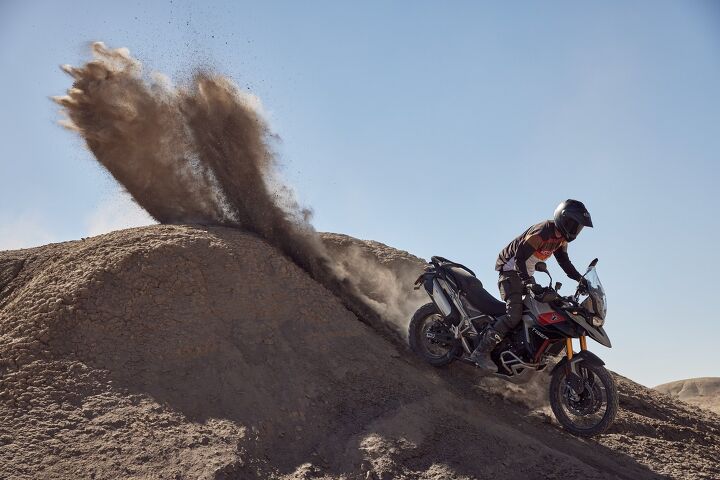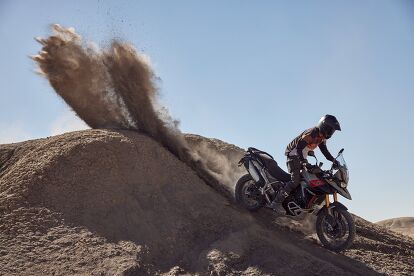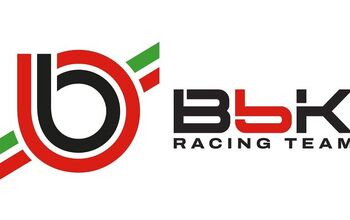2024 Triumph Tiger 900 Range – First Look

More power and better economy for the Tiger 900 GT, GT Pro, and Rally Pro
Triumph has unveiled an updated Tiger 900 family that includes the road-oriented Tiger 900 GT and GT Pro, as well as the off-road focused Tiger 900 Rally Pro. Building on the bike that was originally introduced in 2020, these new versions of Triumph’s middleweight adventure bike improve upon the popular platform by giving the rider more: More power, more capability, and more comfort. But the first change you can actually see is a slightly different look. The 2024 bodywork has been tweaked, from the beak to the side panels, for a more aggressive look, with new paint schemes and graphics to match.
Beefed Up Triple
The clear highlight to the new Tiger 900s is the increase in power from the previous bike. Now the T-Plane Triple delivers a claimed 106.5 hp, a 13% increase in power compared to last year. Also nice is the 66.4 lb-ft of torque delivered even earlier than before, too.
Changes to the engine include new pistons with more compression (13.0:1) than before. There’s also a new cylinder head with larger intake ports and revised exhaust ports with oval castings. Both intake and exhaust camshafts are new and feature higher lift, while the intake trumpets are 15mm longer. Triumph credits these cylinder head improvements as the reason for the bump in power, but it’s also a major reason why the new Tiger 900 line is 9% more fuel efficient than before (Triumph claims 60.4 mpg) while also spewing 9% less CO2 emissions (108 g/km) than the previous bike.
Letting go of the spent gasses is the job of the new exhaust system with a new header assembly that features just a single catalyst compared to the two catalysers before. The exhaust finally passes through a new, redesigned silencer before being released to the atmosphere.
These changes not only lend to the new Tiger 900 engine making more power than before, but doing it virtually everywhere. According to Triumph’s dyno charts, the new engine hovers slightly above in the lower revs, then really breaks free from the old one starting at 6,500 rpm, where it holds a significant advantage all the way to redline. The same thing holds true for the torque figure, where its peak can be felt really early in the rev range, where it also continues until redline.
Other Changes
While the engine updates are definitely the highlight of the new Tiger 900 family, there are other changes, too. The first is a controversial one: linked braking. Technically, Triumph calls it “Enhanced Braking” because the amount of rear brake pressure applied when the rider uses the front brake is mapped depending on speed. For instance, the rear brake won’t even engage if you use the front at low speeds. Chief Engineer Stuart Wood stressed that a lot of care was taken when developing the braking maps to ensure a natural brake feel. Time will tell if he’s right of course, and yes, linked braking is disabled in the Off Road or Off Road Pro ride modes (assuming you choose the Rally Pro).
Lighting is another hot topic with the new Tiger 900s, and in keeping with Euro5 regs, now the hazard lights will flash if you brake aggressively. Otherwise, all the lights on the 900s are now LED, with the turn indicator lights also remaining on at all times for better visibility.
Turning to the dash, there’s now a 7-inch TFT display, which is a very similar unit to the one used on the Tiger 1200 models, with new menus and design compared to the last Tiger 900s. The TFT screen is optically bonded directly to the glass for as clear an image as possible. As per the norm now, the dash is Bluetooth compatible on all 2024 Tigers and gives the ability to connect to the Triumph connectivity system so you can get phone calls, listen to music, or get turn-by-turn navigation.
Rider touchpoints get a small makeover, as the seat is now flatter and roomier, giving the rider more space to move around. Seat height is adjustable 20mm, with the GT and GT Pro having a range between 32.2 inches (820mm) and 33.0 inches (840mm), while the Rally Pro gives a range between 33.8 inches (860mm) and 34.6 inches (860mm). If all of these are too high for you, there’s an accessory low seat that lowers the seat height approximately another half-inch (20mm), to bring the seat as low as 31.4 inches (800mm). Previously, Triumph offered kits to lower the suspension to reduce seat height even further, but this is no longer an option. Both the GT Pro and Rally Pro get heated seats as standard.
The bars themselves get a redesigned damped mounting system, and on the Rally Pro model they’re 15mm closer to the rider for better control while sitting or standing.
What Hasn’t Changed
From an electronics and chassis standpoint, the Tiger 900s are largely unchanged from before.
This includes:
- Optimized cornering ABS and traction control with IMU
- Up to six riding modes including Road, Rain, Sport, and Off-Road, plus Rider configurable for the GT Pro and Rally Pro, and Off-Road Pro for the Rally Pro only
- Triumph Shift Assist (GT Pro & Rally Pro)
- Heated grips and seats (GT Pro & Rally Pro)
- Illuminated switches
- Tire pressure monitoring system (GT Pro & Rally Pro)
- Brembo Stylema Monobloc brakes
- The GT features Marzocchi 1.77” (45mm) USD fully adjustable cartridge forks, rear suspension unit with manually adjustable preload and rebound damping and 7.08” (180mm) fork travel & 6.7” (170mm) rear wheel travel
- The Rally Pro benefits from Showa 1.77" (45mm) USD fully adjustable cartridge forks with manual preload, rebound and compression damping, and a rear suspension unit with fully adjustable manual preload and rebound damping, 9.45" (240mm) fork travel & 9.05" (230mm) rear wheel travel
- Lightweight modular frame
- Adjustable screen and .79" (20mm) adjustable seat height
- 5.28-gal (20 liter) fuel tank
As far as differences between the models, the road-focused GT and GT Pro have lightweight cast alloy wheels, 19” at the front and 17” at the rear, for a balance that’s clearly road biased but can handle some light off-road work. The Rally Pro goes in the other direction and uses tubeless spoked wheels with a 21” front for pure off-road performance and offers a broad tire choice.
Accessory Packages
As we’ve come to expect, Triumph has developed over 50 accessories alongside the development of the Tiger 900 range. But in an interesting twist, there are now four different accessory packages available: Performance, Protection, Trekker and Expedition.
The Performance package is highlighted by a new Akrapovic silencer, which is the first product from Triumph’s new partnership with the company. It’s lightweight titanium with a carbon end cap and shaves 2.2 lbs (1kg) over the standard exhaust. Not to mention it sounds better, too. The Performance pack also includes new scrolling LED indicators, Triumph Shift Assist, LED fog lights, center stand, and machined footpegs.
The Protection package is as the name implies. It includes upper and lower engine crash bars, a tank pad, sump guard, fork protectors, radiator guard, and a headlight guard.
The Trekker and Expedition packages offer similar luggage options (both produced by Givi) depending on whether you opt for the GT/GT Pro or the Rally Pro. The Trekker is designed for the GT and GT Pro and offers molded panniers with side/corner openings. There’s also a 52L top box with a padded passenger backrest that’s able to hold two helmets. This kit also offers the option of steel mounting rails and waterproof inner bags.
Finally, the Expedition package is geared toward the adventure rider looking to cover some distance. It includes aluminum alloy panniers with a top opening, a 42L top box (also with passenger backrest), and a choice of a black or brushed metal finish. It, too, is available with steel mounting rails and waterproof inner bags.
Colors and Pricing
Both the Tiger 900 GT and GT Pro will be available in three color options: Snowdonia White, Carnival Red, and Graphite. The Tiger 900 Rally Pro comes in Carbon Black/Sapphire Black, Matt Khaki Green/Matt Phantom Black, and Ash Grey/Intense Orange. Pricing starts at $14,995 for the GT, $16,895 for the GT Pro, and $17,395 for the Rally Pro. Orders can be placed now at Triumph dealers, with bikes available from early 2024.
Specifications | Tiger 900 GT | Tiger 900 GT Pro | Tiger 900 Rally Pro |
|---|---|---|---|
MSRP | Starts at $14,995 | Starts at $16,895 | Starts at $17,395 |
Engine Type | Liquid Cooled, 12 valve, DOHC, inline 3-cylinder | ||
Bore x stroke | 78.0 mm x 61.9 mm | ||
Capacity | 888 cc | ||
Horsepower | 106.5 HP @ 9,500 rpm (claimed) | ||
Torque | 66.38 Lb-Ft @ 6,850 rpm (claimed) | ||
Compression ratio | 13.0 : 1 | ||
Fueling | Multipoint sequential electronic fuel injection with electronic throttle control | ||
Exhaust | Stainless steel 3 into 1 header system, side-mounted stainless steel silencer | ||
Final drive | O-ring Chain | ||
Clutch | Wet, multi-plate, slip and assist | ||
Gearbox | 6-speed | ||
Frame | Tubular steel trellis main frame. Fabricated, bolt-on aluminum rear subframe | ||
Swingarm | Twin-sided cast aluminum swingarm | ||
Front Suspension | Marzocchi 1.77” (45mm) upside-down forks, manual rebound and compression damping adjustment, 7.08” (180mm travel) | Showa 1.77” (45mm) USD forks, manual preload, rebound and compression damping adjustment, 9.45” (240mm) travel | |
Rear Suspension | Marzocchi rear suspension unit, manual preload and rebound damping adjustment 6.7” (170mm) wheel travel | Marzocchi rear suspension unit, electronically adjustable preload and rebound damping 6.7” (170mm) wheel travel | Showa rear suspension unit, manually adjustable preload and rebound damping 9.05” (230mm) wheel travel |
Front Brake | Twin 320mm floating discs, Brembo Stylema 4 piston Monobloc calipers. Radial front master cylinder, Optimized Cornering ABS | ||
Rear Brake | Single 10.03” (255mm) disc. Single piston sliding caliper. Optimized cornering ABS | ||
Instruments | Full-color 7” TFT instrument pack with My Triumph Connectivity System | ||
Front Wheel | Cast aluminum, 19 x 2.5 in | Spoked tubeless, 21 x 2.15 in | |
Rear Wheel | Cast aluminum, 17 x 4.25 in | Spoked tubeless, 17 x 4.25 in | |
Front Tire | Metzeler Tourance Next, 100/90-19 | Bridgestone Battlax Adventure 90/90-21 | |
Rear Tire | Metzeler Tourance Next, 150/70R17 | Bridgestone Battlax Adventure 150/70-R17 | |
Wheelbase | 61.25" (1556 mm) | 61.06" (1551 mm) | |
Rake/Trail | 24.6°/TBC | 24.4°/TBC | |
Seat Height | Adjustable 32.28” (820 mm) – 33.07” (840 mm) | Adjustable 33.85” (860 mm) – 34.64 (880 mm) | |
Fuel Capacity | 5.28 gal (20 litres) | ||
Length | 90.74” (2305 mm) | 90.74” (2317 mm) | |
Height (without mirrors) | Adjustable 55.51” (1410 mm) – 57.48” (1460 mm) | Adjustable 57.16” (1452 mm) – 59.13” (1502 mm) | |
Width (handlebars) | 36.61” (930 mm) | 36.81” (935 mm) | |
Curb Weight | 482.81 lbs (219 kg) (claimed) | 489.42 lbs (222 kg) | 502.65 lbs (228 kg) |
Fuel Consumption (claimed) | 60.4 mpg (4.7 litres / 100 km) | ||
CO2 Figures | 108 g/km | ||
Standard | EURO 5+ | ||
Service Interval | 6,000 miles (10,000 km) or 12 months, whichever comes first | ||
Become a Motorcycle.com insider. Get the latest motorcycle news first by subscribing to our newsletter here.

Troy's been riding motorcycles and writing about them since 2006, getting his start at Rider Magazine. From there, he moved to Sport Rider Magazine before finally landing at Motorcycle.com in 2011. A lifelong gearhead who didn't fully immerse himself in motorcycles until his teenage years, Troy's interests have always been in technology, performance, and going fast. Naturally, racing was the perfect avenue to combine all three. Troy has been racing nearly as long as he's been riding and has competed at the AMA national level. He's also won multiple club races throughout the country, culminating in a Utah Sport Bike Association championship in 2011. He has been invited as a guest instructor for the Yamaha Champions Riding School, and when he's not out riding, he's either wrenching on bikes or watching MotoGP.
More by Troy Siahaan






































































Comments
Join the conversation
6,000-mile service intervals. Unless you can do it yourself that can be expensive.
Hmm... No mention of the 850. Any news?